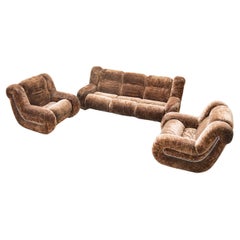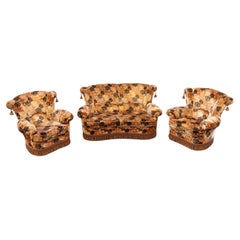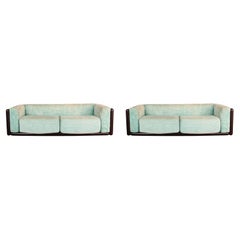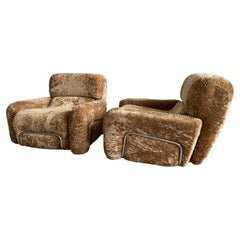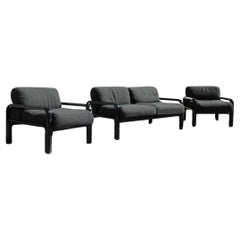Chenille Living Room Sets
5
to
5
5
5
5
3
5
5
5
Height
to
Width
to
Depth
to
2
2
1
553
1,815
1,715
774
643
5
5
2
2
Material: Chenille
Carlo Scarpa Iroko Wood and Green Velvet Cornaro Sofa for Studio Simon, 1974
Located in Vicenza, IT
Cornaro two-seater sofa, designed by Carlo Scarpa and manufactured by Studio Simon in 1974.
Made of Iroko wood, foam, and azure chenille velvet.
Excellent vintage condition.
Born in Venice on June 2nd, 1906, Carlo Scarpa began working very early. Only a year after he had first qualified as an architect in 1926, he began working for the Murano glassmakers Cappellin & Co. in a consultative capacity; from 1927, he began to experiment with the Murano glass, and this research not only gave him excellent results here but would also inform his progress for many years to come. Between 1935 and 1937, as he entered his thirties, Carlo Scarpa accepted his first important commission, the renovation of Venice’s Cà Foscari. He adapted the spaces of this stately University building which stands on the banks of the Grand Canal, creating rooms for the Dean’s offices and a new hall for academic ceremonies; Mario Sironi and Mario De Luigi were charged with doing the restoration work on the frescos. After 1945, Carlo Scarpa was constantly busy with new commissions, including various furnishings and designs for the renovation of Venice’s Hotel Bauer and designing a tall building in Padua and a residential area in Feltre, all worth mentioning. One of his key works, despite its relatively modest diminished proportions, was the first of many works which were to follow in the nineteen fifties: the [bookshop known as the] Padiglione del Libro, which stands in Venice’s Giardini di Castello and shows clearly Scarpa’s passion for the works of Frank Lloyd Wright. In the years which were to follow, after he had met the American architect, Scarpa repeated similar experiments on other occasions, as can be seen, in particular, in the sketches he drew up in 1953 for villa Zoppas in Conegliano, which show some of his most promising work. However, this work unfortunately never came to fruition. Carlo Scarpa later created three museum layouts to prove pivotal in how twentieth-century museums were set up from then on. Between 1955 and 1957, he completed extension work on Treviso’s Gipsoteca Canoviana [the museum that houses Canova’s sculptures] in Possagno, taking a similar experimental approach to the one he used for the Venezuelan Pavilion at [Venice’s] Giardini di Castello which he was building at the same time (1954-56). In Possagno Carlo Scarpa was to create one of his most incredible ever works, which inevitably bears comparison with two other museum layouts that he was working on over the same period, those of the Galleria Nazionale di Sicilia, housed in the Palazzo Abatellis in Palermo (1953-55) and at the Castelvecchio in Verona (1957- 1974), all of which were highly acclaimed, adding to his growing fame. Two other buildings, which are beautifully arranged in spatial terms, can be added to this long list of key works that were started and, in some cases, even completed during the nineteen fifties. After winning the Olivetti Award for architecture in 1956, Scarpa began work in Venice’s Piazza San Marco on an area destined to house products made by the Industrial manufacturers Ivrea. Over the same period (1959-1963), he also worked on renovating and restoring the gardens and ground floor of the Fondazione Querini Stampalia in Venice, which many consider one of his greatest works. While he worked on-site at the Fondazione Querini Stampalia, Carlo Scarpa also began building a villa in Udine for the Veritti family. To shed some light on how much his work evolved over the years, it may be useful to compare this work with that of his very last building, villa Ottolenghi Bardolino, which was near completion at the time of his sudden death in 1978. Upon completion of villa Veritti over the next ten years, without ever letting up on his work on renovation and layouts, Scarpa accepted some highly challenging commissions which were to make the most of his formal skills, working on the Carlo Felice Theatre in Genoa as well as another theatre in Vicenza.
Towards the end of this decade, in 1969, Rina Brion commissioned Carlo Scarpa to build the Brion Mausoleum in San Vito d’Altivole (Treviso), a piece he continued to work on right up until the moment of his death. Nevertheless, even though he was totally absorbed by work on this mausoleum, plenty of other episodes can offer some insight into the final years of his career. As work on the San Vito d’Altivole Mausoleum began to lessen in 1973, Carlo Scarpa started building the new headquarters for the Banca Popolare di Verona. He drew up plans that were surprisingly different from the work he carried out simultaneously on the villa Ottolenghi. However, the plans Carlo Scarpa drew up, at different times, for a monument in Brescia’s Piazza della Loggia commemorating victims of the terrorist attack on May 28th, 1974, make a sharp contrast to the work he carried out in Verona, almost as if there is a certain hesitation after so many mannered excesses. The same Pietas that informs his designs for the Piazza Della Loggia can also be seen in the presence of the water that flows through the Brion Mausoleum, almost as if to give a concrete manifestation of pity in this twentieth-century work of art. Carlo Scarpa has put together a highly sophisticated collection of structures occupying the mausoleum’s L-shaped space stretching across both sides of the old San Vito d’Altivole cemetery. A myriad of different forms and an equally large number of different pieces, all of which are separate and yet inextricably linked to form a chain that seems to offer no promise of continuity, arising out of these are those whose only justification for being there is to bear the warning “si vis vitam, para mortem,” [if you wish to experience life prepare for death] as if to tell a tale that suggests the circle of time, joining together the commemoration of the dead with a celebration of life. At the entrance of the Brion Mausoleum stand the “propylaea,” followed by a cloister that ends by a small chapel, with an arcosolium bearing the family sarcophagi, the central pavilion, held in place on broken cast iron supports, stands over a mirror-shaped stretch of water and occupies one end of the family’s burial space. The musical sound of the walkways, teamed with the luminosity of these harmoniously blended spaces, shows how, in keeping with his strong sense of vision, Carlo Scarpa could make the most of all his many skills to come up with this truly magnificent space. As well as an outstanding commitment to architectural work, with the many projects we have already seen punctuating his career, Carlo Scarpa also made many equally important forays into the world of applied arts. Between 1926 and 1931, he worked for the Murano glassmakers Cappellin, later taking what he had learned with him when he went to work for the glassmakers Venini from 1933 until the 1950s. The story of how he came to work on furniture design is different, however, and began with the furniture he designed to replace lost furnishings during his renovation of Cà Foscari. The later mass-produced furniture started differently, given that many pieces were originally one-off designs “made to measure.” Industrial manufacturing using these designs as prototypes came into being thanks to the continuity afforded him by Dino Gavina, who, as well as this, also invited Carlo Scarpa to become president of the company Gavina SpA, later to become SIMON, a company Gavina founded eight years on, in partnership with Maria Simoncini (whose own name accounts for the choice of company name). Carlo Scarpa and Gavina forged a strong bond in 1968 as they began to put various models of his into production for Simon, such as the “Doge” table, which also formed the basis for the “Sarpi” and “Florian” tables. In the early seventies, other tables that followed included “Valmarana,” “Quatour,” and “Orseolo.” While in 1974, they added a couch and armchair, “Cornaro,” to the collection and the “Toledo” bed...
Category
1970s Italian Mid-Century Modern Vintage Chenille Living Room Sets
Materials
Velvet, Foam, Chenille, Wood
Living room set, 3-seater sofa and 2 beige chenille armchairs, 1970s
Located in Manzano, IT
Living room set, 3-seater sofa and 2 beige chenille armchairs, 1970s
Wooden frame, chenille fabric, aluminum and chrome iron feet
CONDITIONS Good, signs of wear in fabric and lack of...
Category
1970s Italian Vintage Chenille Living Room Sets
Materials
Aluminum, Iron
Sitting room composed of 3-seater sofa and 2 armchairs, 1970s Baroque style.
Located in Manzano, IT
Sitting room composed of 3-seater sofa and 2 armchairs, 1970s Baroque style.
Floral chenille fabric embellished with bangs. The cushions are removable and washable. Item never used, ...
Category
1970s Italian Vintage Chenille Living Room Sets
Materials
Iron
Carlo Scarpa Iroko and Velvet Cornaro Sofa for Studio Simon, 1974, Set of 2
Located in Vicenza, IT
Set of 2 Cornaro two-seater sofas, designed by Carlo Scarpa and manufactured by Studio Simon in 1974.
Made of Iroko wood, foam, and azure chenille velvet.
Excellent vintage conditi...
Category
1970s Italian Mid-Century Modern Vintage Chenille Living Room Sets
Materials
Chenille, Velvet, Foam, Wood
Mid-Century Modern Italian Pair of Chrome and Chenille Armchairs, 1970s
Located in Prato, IT
Mid-Century Modern Italian pair of chrome and chenille armchairs with original beige color upholstery.
The set is in perfect vintage conditions
If a different upholstery is required,...
Category
1970s Italian Mid-Century Modern Vintage Chenille Living Room Sets
Materials
Chrome
Related Items
Living Room Sets Gae Aulenti for Knoll 1970s Black Grey Italian Style
By Gae Aulenti
Located in Palermo, Sicily
Living Room Sets Gae Aulenti for Knoll 1970s Black Grey
Category
1970s Italian Mid-Century Modern Vintage Chenille Living Room Sets
Materials
Metal
H 29.53 in W 61.03 in D 37.41 in
Scandinavian living room set with two armchairs and a sofa, 1960s
Located in Parma, IT
Complete living room with a pair of armchairs and a three-seater sofa, Scandinavian production of the 1960s.
Structure in maple wood with seat, backrest and armrests in fabric, detai...
Category
1960s Scandinavian Mid-Century Modern Vintage Chenille Living Room Sets
Materials
Fabric, Wood
Mid-Century Modern French Three-Seat Sofa by Gérard Guermonprez, 1970s
Located in Prato, IT
Mid-Century Modern French three-seat sofa with original velvet fabric designed by Gérard Guermonprez.
The sofa presents some wear consistent with age and use.
It can become a set ...
Category
1970s French Mid-Century Modern Vintage Chenille Living Room Sets
Materials
Chrome
H 25.2 in W 96.46 in D 35.44 in
French Living Room Set Louis XV - Sofa and Pair of Armchair - 19th - France
Located in Beuzevillette, FR
Beautiful Napoleon III period living room in blackened wood garnished with a velvet decorated with bouquets of flowers, including a bench and two armchairs. The very original movemen...
Category
1860s French Louis XV Antique Chenille Living Room Sets
Materials
Velvet, Wood
H 41.54 in W 67.72 in D 32.68 in
Vintage leatherette living room set, 1970´s, Czechoslovakia
Located in Prague 8, CZ
This leatherette living room set is a typical example of furniture design of the 1970/1980´s
It was made in Czechoslovakia.
The furniture is in very good Vintage condition, showing s...
Category
Late 20th Century Czech Mid-Century Modern Chenille Living Room Sets
Materials
Faux Leather, Wood
Mid-Century Modern Italian Three-Seat "Coronado" Sofa by Tobia Scarpa for B&B
Located in Prato, IT
Mid-Century Modern Italian three-seat flamingo pink velvet "Coronado" sofa by Tobia Scarpa for B&B. Project from 1960s
The sofa can come as a living room set together with its pair ...
Category
1970s Italian Mid-Century Modern Vintage Chenille Living Room Sets
Materials
Velvet, Wood
H 29.93 in W 84.65 in D 35.44 in
Vintage Modular Leatherette Living Room Set, 1970´s
Located in Prague 8, CZ
This leatherette modular living room set is a typical example of furniture design of the 1970/1980´s
It was made in Western Europe.
It can used as a) 4-seater sofa, b) corner sofa ...
Category
Late 20th Century European Mid-Century Modern Chenille Living Room Sets
Materials
Faux Leather, Wood
Italian Mid-Century Natural Leather Space Age Armchairs, 1970s
Located in Traversetolo, IT
A stunning pair of armchairs made in Italy in the 1970s. The seat is very comfortable and supportive. The pads are still original and in very good condition. Original natural leather...
Category
1970s Italian Space Age Vintage Chenille Living Room Sets
Materials
Metal
Afra & Tobia Scarpa “Soriana” Sofa for Cassina, Bouclé Wool, 1969
Located in Lonigo, Veneto
Afra & Tobia Scarpa “Soriana” three-seater for Cassina, bouclé wool and chromed steel, Italy, 1969.
Although technically designed in the 1960s, the "Soriana" model by the Italian duo Tobia and Afra Scarpa is firmly associated with the next decade, when its popularity peaked. "Soriana" is low and invites you to sink into its curves. Its most notable feature, however, is the Minimalist structure in chromed steel. This external structure in steel rod keeps the cover taut using buttons...
Category
1960s Italian Mid-Century Modern Vintage Chenille Living Room Sets
Materials
Chrome
Pair of Mid-Century Modern Chrome and Chenille Armchairs
Located in Hopewell, NJ
Sleek pair of armchairs having elegant chrome frames, newly upholstered in a schnazzy geometric chenille fabric.
SW.
Category
1970s American Mid-Century Modern Vintage Chenille Living Room Sets
Materials
Chrome
Living Room of the 1970s Leather and Curved Chrome Metal Italian Design
By Poltronova
Located in Palermo, Sicily
Minimal living room of the 1970s leather and curved chrome metal Italian design, the structure is made of chromed metal, the brown leather pillows...
Category
1970s Italian Mid-Century Modern Vintage Chenille Living Room Sets
Materials
Metal, Chrome
H 31.5 in W 75.99 in D 32.68 in
Carlo Scarpa Cornaro Loveseat / Armchair, Original Fabric, Italy, 1970s
By Carlo Scarpa
Located in London, GB
An original Carlo Scarpa Cornaro loveseat / armchair, original fabric, Italy. Produced by Gavina in the 1970s. We can reupholster in COM at additional cost. Fast shipping worldwide.
...
Category
Mid-20th Century Italian Mid-Century Modern Chenille Living Room Sets
Materials
Chrome
H 25.2 in W 55.12 in D 33.86 in
Previously Available Items
Corner Piece in Green Chenille, 1970, Italy
Located in Premariacco, IT
Upholstered corner unit with a modern and functional design, Italian production around the 70s.
The fabric is in green chenille lined at the base wit...
Category
1970s Italian Mid-Century Modern Vintage Chenille Living Room Sets
Materials
Aluminum
Set of Two Green Chenille Armchairs with Pouf, 1970, Italy
Located in Premariacco, IT
Set of upholstered armchairs with a modern and functional design, Italian production around the 70s.
Elegant and refined matching ottoman included.
The fabric is in green cheni...
Category
1970s Italian Mid-Century Modern Vintage Chenille Living Room Sets
Materials
Aluminum
Modular Seating in Green Chenille, 1970, Italy
Located in Premariacco, IT
Upholstered seating set with a modern and functional design, Italian production around the 70s.
The fabric is in green chenille, while at the feet we...
Category
1970s Italian Mid-Century Modern Vintage Chenille Living Room Sets
Materials
Aluminum
Art Deco Salon Set by Jules Leleu
By Jules Leleu
Located in Miami, FL
A salon set by Jules Leleu made out of a solid mahogany frame and upholstered in fabric.
Made in France, circa 1935
Reference: House of Leleu by Francoise Siriex, Page 73.
Category
Early 20th Century French Art Deco Chenille Living Room Sets
Materials
Chenille, Mahogany, Rosewood
Rare Howard & Son's Fully Stamped Four-Piece Suite, Pair of Armchairs and Sofas
Located in GB
We are delighted to offer this lovely original Howard & Sons four-piece suite
The suite costs in the tens of thousands to have made new today
Please note the delivery fee ...
Category
Early 2000s Great Britain (UK) Modern Chenille Living Room Sets
Materials
Chenille, Beech, Feathers
H 29.93 in W 88.98 in D 37.8 in
Double Sofa and Side Table Sectional Unit by John Stuart
Located in New York, NY
John Stuart sectional comprised of 2 love seats and a corner table on high tapered legs. Original wheat color chenille fabric on spring cushions. It has a...
Category
20th Century American Chenille Living Room Sets
Materials
Walnut, Chenille
1930's Art Deco Bamboo Sofa and Chairs Lounge Set
Located in Los Angeles, CA
Beautiful bamboo sofa part of a lounge set with two other chairs and ottoman. Newer beige and sage chenille upholstery, loose cushions. Absolutely gorgeous! Priced as a whole set. Wi...
Category
1930s American Vintage Chenille Living Room Sets
Materials
Bamboo, Chenille, Upholstery
Chinese Deco Sofa Suite
Located in Chicago, IL
A rosewood square arm Chinese Deco sofa and chairs suite from 1930's Shanghai, China with new beige chenille upholstery. PRioce includes two chairs and one sofa. Sofa dimensions: ...
Category
1930s Chinese Vintage Chenille Living Room Sets
Materials
Chenille, Upholstery
Recently Viewed
View AllMore Ways To Browse
Austrian Leather Living Room Sets
1880 Sofa And Chairs
European Mahogany Living Room Sets
1 Sofa And 4 Armchair
Mother And Cub
British Animal Skin Living Room Sets
Leather Lounge Suites Used
Victorian Sofa Set
Victorian Couch Set
French Bergere Couch
Late 20th Century Plastic Living Room Sets
Scandinavian Modern Animal Skin Living Room Sets
Art Nouveau Salon Set
Louis Xvi Salon Set
Louis Xvi Salon Sets
Rattan Suite
Tired Man Chair
The Tired Man Chair

